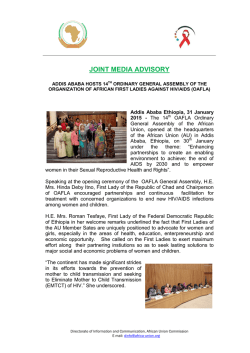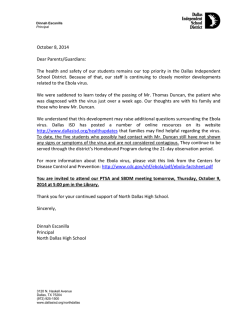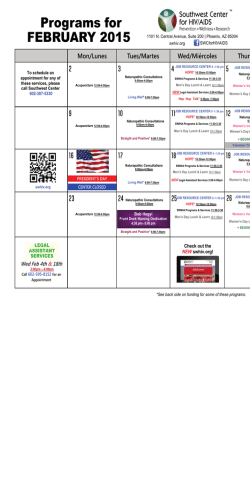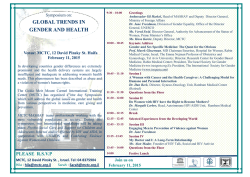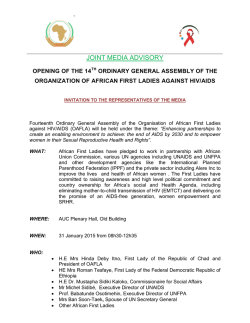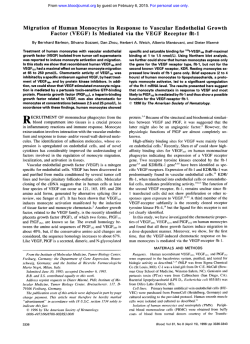
efficient isolation and propagation of human immunodeficiency virus
Published April 1, 1988
EFFICIENT ISOLATION AND PROPAGATION OF
HUMAN IMMUNODEFICIENCY VIRUS ON RECOMBINANT
COLONY-STIMULATING FACTOR I-TREATED MONOCYTES
BY HOWARD E. GENDELMAN,* JAN M. ORENSTEIN,° MALCOLM A. MARTIN,*
CAROL FERRUA,* RITA MITRA, 4 TERRI PHIPPS," LARRY A. WAHL,"
H. CLIFFORD LANE,f ANTHONY S . FAUCI,f DONALD S. BURKE,T
DONALD SKILLMAN," AND MONTE S. MELTZERl
Infection with the human immunodeficiency virus (HIV) (1-3) often results
in clinically apparent disease only after intervals of months to years. During this
latent or subclinical phase of infection, HIV continues to replicate at low levels
despite an often vigorous but apparently ineffective host immune response (4) .
Mechanisms that contribute to this persistent, low-level infection, as well as the
cellular reservoirs for HIV during this latent period, are not fully understood .
Several lines of evidence now document cells of the monocyte/macrophage lineage as major targets for persistent HIV in vivo (5-12) . In this respect, HIV is
similar to several ruminant lentiviruses that show strong tropism for macrophages during both viral latency and active replication (13-15) . If macrophages
also serve as a viral reservoir during HIV infection, then analysis of these
infected cells may explain mechanisms of viral persistence, dissemination, and
ultimately clinical disease.
In this report, we describe an in vitro system that allows replication of HIV
in blood-derived monocyte/macrophages from normal donors . Purified monocytes were cultured for intervals > 3 mo in medium supplemented with human
rCSF-1 (16, 17) . These cultures provided susceptible target cells for HIV infection. Cocultivation of PBMC from patients with AIDS or AIDS-related complex
(ARC)' and rCSF-1-treated monocytes from normal donors resulted in isolation
of progeny HIV virions in the majority of patients tested .
Materials and Methods
Populations of monocytes were isolated by countercurrent centrifugal elutriation of mononuclear leukocyte-rich fractions
Isolation and Culture of Peripheral Blood Monocytes.
H. E. Gendelman is a Carter-Wallace Fellow of Columbia University College of Physicians and Surgeons, New York, NY. Address correspondence to Dr. M. S. Meltzer, Department of Immunology,
Walter Reed Army Institute of Research, Washington, DC 20307.
1 Abbreviations used in this paper: ARC, AIDS-related complex; UA, uranyl acetate.
1428
J. Exp. MED. © The Rockefeller University Press - 0022-1007/88/04/1428/14 $2 .00
Volume 167 April 1988 1428-1441
Downloaded from on October 2, 2016
From the *Laboratory of Molecular Microbiology, National Institute of Allergy and Infectious
Diseases ; the LLaboratory of Microbiology and Immunology, National Institute of Dental Research;
and the 'Laboratory of Immunoregulation, NIAID, National Institutes of Health, Bethesda,
Maryland 20892 ; the °Department of Pathology, George Washington University Medical Center,
Washington, DC 20036; and the $Walter Reed Army Institute to Research, Walter Reed Army
Medical Center, Washington, DC 20307
Published April 1, 1988
GENDELMAN ET AL .
1429
Downloaded from on October 2, 2016
of blood cells from normal donors undergoing leukopheresis (18). Cell suspensions were
> 96% monocytes by the criteria of cell morphology on Wright-stained cytosmears (96
± 2%, mean ± SEM for six determinations), by granular peroxidase (95 ± 3%), and by
nonspecific esterase (98 ± 2%) . Elutriated monocytes were cultured as adherent cell
monolayers in DMEM (formula 780176AJ, Gibco, Grand Island, NY) supplemented with
10% freshly obtained, heat-inactivated, normal human serum, 50 Ag/ml gentamicin, and
1,000 U/ml rCSF-1 (Cetus Corp., Emeryville, CA) (16, 17) .
Isolation and Culture of PHA-stimulated PBMC (Lymphoblasts) . PBMC isolated from
whole blood by Ficoll-diatrizoate density grandient centrifugation were cryopreserved
and stored in liquid nitrogen. 3 d before use for virus isolation, cells were quickly thawed
and stimulated with the T cell mitogen, PHA (1-3).
Virus Isolation by Monocyte or Lymphoblast Cocultivation. Monocytes treated with rCSF1 and maintained in culture for at least 7 d were used for cocultivation experiments with
freshly isolated PBMC from seropositive HIV-infected individuals . Aliquots of Ficoll-diatrizoate-separated PBMC (5 X 105 cells/culture well) were admixed with equal numbers
of adherent rCSF-1-treated monocytes in 16-mm-diameter culture wells (Cluster24;
Costar Data Packaging Corp., Cambridge, MA) or with suspensions of PHA-stimulated
lymphoblasts (1-3). Fluids from all cultures were sampled daily and assayed by ELISA
(Cellular Products, Inc ., Buffalo, NY) for presence of HIV-specific antigens and/or
reverse transcriptase activity for at least 40 d. Reverse transcriptase assays were performed with [ 2P] deoxythymidinetriphosphate in a protocol modified from that
described by Goff et al. (19, 20).
Immunofuorescence Analysis by Flow Cytometry. Uninfected (10 d) and HIV-infected (40
d) rCSF-1-treated monocytes were cultured and recovered from Teflon-coated tissue culture flasks (Cole-Parmer Instrument Co., Chicago, IL) . For all experiments, 106 cells
were incubated with 1 :100 dilution of mAb anti-HLe-1 (CD45, Becton Dickinson & Co.,
Mountain View, CA), Leu-M3 (CD 14, Becton Dickinson & Co.) B4 (CD 19), J5 (CD10),
T4 (CD4), T6 (CD 1), T8 (CD8), and TI 1 (CD2 ; all from Coulter Immunology, Hialeah,
FL) or 1 :50 dilution of pooled AIDS patients' sera from HIV-1- and HIV-2-infected
individuals. After the initial antibody incubation, cells were washed after centrifugation
and resuspended in 1 :100 dilution of fluorescein-conjugated horse anti-mouse or goat
anti-human IgG. Immunofluorescence of individual cells previously fixed in 1 % paraformaldehyde were analyzed by FACS flow cytometry .
Detection of HIV-specific Polypeptides by Radioimmunoprecipitation. Adherent monolayers
of rCSF-1-treated monocytes chronically infected (30 d) with HIV-1 (patient Ada, second
passage) were washed twice and cultured in methionine-free DMEM with 2% dialyzed
FCS for 2 h. Cells were labeled with ["S]methionine (100 ,ACi/ml) for 8 h. Radiolabeled
cell lysates were mixed with AIDS patients' sera for 12 h at 4°C and the immune complexes were recovered on protein A-Sepharose (Pharmacia Fine Chemicals, Piscataway,
NJ) . Eluted immune complexes were subjected to SDS-PAGE as described (21).
Detection of HIV-specific DNA by Southern Blot Hybridization. DNA was prepared from
HIV-infected (patient 120 isolate, second passage at 30 d) rCSF-l-treated monocytes and
analyzed for presence of virus-related sequences by Southern blot hybridization of Hind
III-digested cellular DNA with the pBenn6 gag-pol-env probe (22).
In Situ Hybridization with HIV RNA Probes. Subgenomic viral DNA fragments present
in pBI (23), pBenn6 (22), pBl l (23), and a recombinant plasmid (pRG-B) that contains
a 1 .35-kb Hind III fragment mapping between 8.25 and 9.6 kb on the proviral DNA
were subcloned into SP6/T7 vectors (Promega Biotec, Madison, WI), and the pooled
DNAs were transcribed using 3 'S-UTP (Amersham Corp., Arlington Heights, IL) . The
labeled RNAs were incubated with 40 mM NaHCO3/60 AM Na2COs, pH 10.2, before
hybridization to facilitate their entry into cells . Cytosmears of cultured monocytes were
prepared onto polylysine-coated glass slides, fixed in periodate/lysine paraformaldehyde/
glutaraldehyde, and pretreated with proteinase K, triethanolamine, and HCl . Specimens
were prehybridized in 10 mM Tris (pH 7.4), 2X SSC (1X SSC is 0.15 M NaCl, 0.015 M
sodium citrate, pH 7.4), 1X Denhardt's solution (0.02% polyvinylpyrrolidone, 0 .02%
Ficoll, 0.02% BSA), and 200 Ag/ml yeast tRNA at 45°C for 2 h, and hybridized in this
Published April 1, 1988
1430
ISOLATION OF HUMAN IMMUNODEFICIENCY VIRUS
solution with 10% dextran sulfate, 5 uM dithiolthreitol and 10 6 cpm 35S-labeled HIV
RNA. Slides were serially washed in solutions with RNase to reduce binding of nonhybridized probe. Autoradiography was performed in absolute darkness (6).
To control for the specificity of in situ hybridization, probes synthesized in the sense
orientation (same polarity as viral mRNA) were incubated with replicate cell preparations. Additionally, uninfected cells were hybridized with antisense probes (i .e ., complementary to viral mRNA) .
EM Examination of Monocyte Cultures . HIV-infected or uninfected rCSF-1-treated
monocytes were grown on plastic dishes or recovered from Teflon flasks . Cells were harvested at 10 and 40 d, washed in PBS, and immediately fixed with 2% glutaraldehyde in
0.1 M cacodylate buffer (pH 7.4) overnight at 4°C. Fixed cells were gently transferred
to 1.5-ml microfuge tubes using a large-bore Pasteur pipette and were pelleted after
centrifugation . The cell pellet was further processed through 1% Os04, blocked in uranyl
acetate (UA), stained for 1 h in saturated UA in 50% ethanol, dehydrated in graded
ethanol and propylene oxide, and embedded in epon . Thin sections were stained with
UA and lead citrate and examined in a Zeiss EM I OAR EM operating at 60 kV.
Culture of rCSF-1-treated Blood Monocytes. Relatively pure populations of
monocytes were obtained by countercurrent centrifugal elutriation of mononuclear leukocyte-rich fractions of blood cells from normal donors undergoing leukopheresis (18) . Such cell suspensions were > 96% monocytes by criteria of cell
morphology on Wright-stained cytosmears, by granular peroxidase, and by nonspecific esterase . Purified monocytes were cultured in medium supplemented
with 1,000 U/ml rCSF-1 . After 5-7 d of culture, clusters of rounded, loosely
adherent, proliferating monocytes were observed scattered throughout a monolayer of adherent fusiform cells (Fig . 1) . Low levels of cell division were confirmed by [3H] thymidine incorporation and the presence of mitotic figures in
1-5% of the cells. In coincident experiments, monocytes in aliquots of the same
cell suspension cultured without rCSF-1 for 7 d appeared spread, vacuolated,
and granular. No proliferating cell clusters were observed and the absolute cell
number was < 20% of the initial inoculum. In contrast, the number of cells in
rCSF-1-treated monocyte cultures at 7-10 d ranged from 90-150% of the initial
inoculum . EM examination of 100 individual cells after 10 d in culture showed
that all cells had ultrastructural characteristics typical of macrophages: irregular
outlines, abundant lysosomes, prominent perinuclear Golgi, and eccentric
nuclei . Cell surface antigens in these monocyte cultures were also characterized
at 10 d by mAbs and analyzed by FACS flow cytometry. More than 98% of cells
were positive for HLe-1 (CD 45) and Leu-M3 (CD 14); binding of anti-B4 (CD
19), J5 (CD10), T4 (CD 4), T6 (CD1), T8 (CD 8) or T11 (CD2) were each below
levels of detection . Thus by antigenic, histochemical, morphologic, and ultrastructural analysis, virtually all of the cells in these 10-d suspensions were identified as monocytes/macrophages.
Isolation of HIV from PBMC of Seropositive Individuals onto rCSF-1-treated
Monocytes of Normal Donors . Repeated attempts to propagate established laboratory strains of HIV in monocytes were uniformly negative over a time interval
of >6 mo (data not shown) . These attempts were repeated with the rCSF-1treated monocyte culture technique described above. Monocytes treated with
rCSF-1 for at least 7-10 d were used for cocultivation experiments with freshly
Downloaded from on October 2, 2016
Results
Published April 1, 1988
GENDELMAN ET AL .
143 1
Downloaded from on October 2, 2016
Light microscopic characteristics of blood-derived monocytes cultured with
rCSF-1 for (A) 10 and (B) 40 d. Note heterogeneous cell populations : small cells with dense
nuclear chromatin and moderate cytoplasm; larger cells with extensive and diffuse cytoplasm
and eccentric nucleus ; and individual fusiform cells with fibroblast-like morphology ; islands
of aggregated and proliferating cells. Original magnification, X 80 .
FIGURE 1.
isolated PBMC from seropositive HIV-infected individuals (Table I). Aliquots of
PBMC from each of five patients were cocultivated with rCSF-1-treated adherent monocyte monolayers and suspensions of PHA-stimulated PBMC (lymphoblasts) from normal donors. Culture fluids were sampled daily and assayed for
HIV-specific antigens and/or reverse transcriptase . Isolation of HIV was suc-
Published April 1, 1988
143 2
ISOLATION OF HUMAN IMMUNODEFICIENCY VIRUS
TABLE I
Virus Isolation from PBMC of HIV-infected Patients by Monocyte or Lymphoblast
Cocultivation
Patient
CD4+ T
cells/mms
PHA-induced
lymphoblasts
rCSF-1-treated
monocytes
252
cpm/ml X 10 -3
1,000
70 (35 d)
208
900
100 (22 d)
360
200
40 (25 d)
582
500
433
None
None
160 (36 d)
Aliquots of Ficoll-diatrizoate-separated PBMC were admixed with equal numbers of
adherent rCSF-l-treated monocytes or with PHA-stimulated lymphoblasts . Fluids from
all cultures were sampled daily and assayed for HIV-specific reverse transcriptase activity for 40 d. Reverse transcriptase levels represent peak activity . Day at which virus was
first detected in monocyte cultures is shown in parentheses .
cessful in all five patients by cocultivation with rCSF-1-treated monocytes or
lymphoblasts . Antigen-capture assays confirmed isolation of HIV in each
instance. One patient had a lymphoblast isolate and not a monocyte isolate ;
another patient had a monocyte but not a lymphoblast isolate . With three
patients, both monocyte and lymphoblast isolates were obtained; the peak
reverse transcriptase activity and HIV viral antigen level in lymphoblast cultures
were 10-fold higher than those in monocyte cultures .
Progeny virions released in supernatant fluids of infected monocyte and lymphoblast cultures were used to serially infect other rCSF-1-treated monocyte
and lymphoblast cultures . In all cases, viral inoculum was adjusted to 5 X 10'
cpm/ml reverse transcriptase activity in 0.5-ml filtered (0 .22-Am filter units ; Millipore Continental Water Systems, Bedford, MA) culture fluid. HIV initially isolated on monocyte or lymphoblast cultures serially infected normal homologous
cells with all isolates tested . Serial passage of HIV (patient 120 isolate, see Table
1) initially isolated on monocytes into other rCSF-1-treated monocyte cultures
resulted in a progressive increase in viral titer (Fig . 2) . In the second passage,
distinctive changes in cell morphology and some cell death were noted in
monocyte cultures 8-14 d after HIV infection . Appearance of cell debris and
changes in cell morphology in the rCSF-1-treated monocyte monolayer were
coincident with peaks of reverse transcriptase activity in culture fluids. Multinucleated giant cells with > 20 nuclei/cell were noted in 10-20% of monocytes .
Replicate rCSF-1-treated monocytes cultured alone as adherent monolayers or
cocultivated with PBMC from HIV seronegative control donors did not show
these changes . HIV-specific reverse transcriptase activity was detected in culture
Downloaded from on October 2, 2016
Ada: 36-yr-old male homosexual
with Kaposi's sarcoma for 4 yr
Ree: 44-yr-old male homosexual
with Kaposi's sarcoma for I yr
120: 27-yr-old male i.v. drug abuser
with ARC for 1 yr
121 : 32-yr-old male i.v . drug abuser
with ARC for 9 mo
167: 24-yr-old male homosexual
with ARC for 1 yr
HIV reverse transcriptase activity in culture
fluids of patient PBMC cocultivated with :
Published April 1, 1988
GENDELMAN ET AL.
143 3
120
X
_ff
if
FIGURE 2. Serial passage of virus
from PBMC of patient 120 into
h primary
I,
isolation
Control
20
Oat's MW Nation
30
4
fluids through
0__ 40 d. Significantly, at these later t
in the HIV-infected monocyte monolayer appeared morphologically normal .
After three passages on homologous cells, monocyte and lymphoblast HIV
isolates were each added to heterologous cells; in each instance, sustained, productive viral infection was not demonstrated. Similarly, several different strains
of HIV-1, such as lymphadenopathy associated virus or LAV that were each
maintained for long intervals in normal lymphoblasts or continuous T cell lines,
all failed to infect rCSF-1-treated monocyte/macrophage cultures even at viral
inocula 20-fold higher than that needed to infect lymphoblasts. One macrophage-tropic HIV patient isolate (Ado) infected PHA-stimulated lymphoblasts
after five serial passages in rCSF-1-treated monocytes . In marked contrast to the
preceding observations, a well-characterized HIV-2 isolate (ROD) that had been
serially passaged in lymphoblasts and continuous T cell lines (24) infected rCSF1-treated monocytes ; peak reverse transcriptase activity, 2 X 105 cpm/ml, was
detected 8 d after infection .
Characterization of the Macrophage Variant HIV. HIV-specific proviral
was detected by Southern blot hybridization of Hind III-digested DNA prepared from HIV-infected (patient 120 isolate, second passage at 30 d) rCSF-1treated monocytes (Fig. 3 A). Two cleavage products (4.5 and 2.0 kb) reacted
with the pBenn6 DNA probe . Radioimmunoprecipitation of HIV-associated
proteins from [ 3l Sjmethionine-labeled, HIV-infected rCSF-1-treated monocytes
(patient Ada isolate, second passage at 30 d) showed detectable levels of synthesis for envelope Q 160 and gp 12Q and gag (p55 and p39) proteins (Fig. 3 B).
Levels of HIV gene synthesis in chronically infected monocyte cultures were fured by assay of virus-specific RNA and proteins. In situ hybridizati
Downloaded from on October 2, 2016
I ;
I . ,
isolated
rCSF-1treated monocytes. Aliquots of Ficolldiatrizoate-separated PBMC suspensions
from patient 120 were admixed with equal
numbers of adherent rCSF-1-treated
monocytesa
{primry}
isolation . Culture
fluids were sampled daily and assayed for
HIV-specific reverse transcriptase activity.
For each subsequent passage into rCSF-1treated monocytes, viral inoculum was
adjusted to 5 X 10' cpm/mi reverse transcriptase activity in filtered culture fluid
MZ in]).
Published April 1, 1988
1434
ISOLATION OF HUMAN IMMUNODEFICIENCY VIRUS
(A) Detection of HIVspecific DNA by Southern blot
hybridization. DNA was prepared
from HIV-infected (patient 120 isolate, second passage at 30 d) rCSF1-treated monocytes and analyzed
for presence of virus-related sequences by Southern blot hybridization of Hind III-digested DNA with
the pBenn6 probe. (B) Detection of
HIV-specific
polypeptides
by
radioimmunoprecipitation of cell
lysates from adherent monolayers of
rCSF-1-treated monocytes chronically infected (30 d) with HIV-1
(patient Ada, second passage) . Supernatant fluids from [s5S]methionine-labeled cell lysates were mixed
with pooled AIDS patients' sera and
the immune complexes were subjected to SDS-PAGE . Immunoprecipitate bands representing envelope
(gp 160 and gp 120) and gag (p55
and p39) proteins are clearly identified in lane 2. Molecular weight
markers were applied to lane 1 .
FIGURE 3.
Downloaded from on October 2, 2016
of infected monocytes with HIV RNA probes and analysis of the hematoxylinstained cytosmears by autoradiography documented a large subpopulation of
cells (60-90%) that expressed viral RNA (Fig . 4) . Similarly, analysis of chronically infected monocyte populations (patient 120 isolate, second passage at 40
d) by binding of antibodies in AIDS patients' sera as quantified by FACS flow
cytometry also documented a large subpopulation of cells (60-88%) that
expressed viral protein. These results, however, stand in sharp contrast to the
relatively low levels of reverse transcriptase activity or HIV antigens found in
culture fluids . Independent estimates of viral RNA and protein produced by
HIV-infected monocytes suggested a massive infection, yet the amount of virus
released into culture fluids was exceedingly small.
EM analysis of HIV-infected monocyte cultures resolved this apparent paradox. Monocytes chronically infected (40 d) with HIV-1 (patient 120, second passage) initially isolated in rCSF-I-treated monocyte cultures were fixed in 2% glutaraldehyde and were prepared for transmission EM . Virus particles were
identified in ^-15% of macrophages examined . Virions typical of lentiviruses
(25) were numerous (100-300 particles/cell) and uniformly localized to intracytoplasmic vacuoles (Fig. 5) . Viral particle size and nucleoid appearance was
pleomorphic. Virons were commonly seen budding into cytoplasmic vacuoles
but only rare viral particles were observed associated with the plasma membrane. Similar findings were evident in rCSF-1-treated monocytes chronically
Published April 1, 1988
GENDELMAN ET AL .
1435
In situ hybridization of HIV-infected (patient Ada isolate, third passage) rCSF1-treated monocytes . Silver grains (HIV-specific RNA) overlie infected cells.
infected (40 d) with the HIV-2 (ROD) isolate (Fig. 6) . With HIV-1, plasma membrane budding was observed at low levels during the acute phase of infection
(10-14 d), but again intracellular accumulation of virus particles within cytoplasmic vacuoles was the predominant finding .
The pattern of HIV replication in monocytes and T cells is thus very different .
HIV-infected monocytes accumulate large numbers of budded virus in intracytoplasmic vacuoles during both acute and chronic infections ; release of virus
from the plasma membrane is infrequent and at relatively low levels (0-10 particles/cell section) . This pattern of viral replication in rCSF-1-treated monocytes
was observed with three different patient isolates of HIV (patients Ada and
120), and HIV-2 (ROD) ; viral particles were identified in -15% of monocytes
examined at 4-6 wk. In contrast, the HIV-infected T cell releases large numbers
of viral particles from the plasma membrane (often hundreds of virions/cell section) ; the number of virions that reside in cytoplasmic vacuoles in these cells is
exceedingly small . The concept that HIV virions produced in macrophages accumulate intracellularly and are only inefficiently transported out of the cell was
confirmed by comparison of fluid-phase reverse transcriptase levels in monocyte
cultures before and after three successive freeze-thaw cycles . The amount of
reverse transcriptase activity detected in monocyte cultures after the freeze-thaw
cycles was 10-20 times higher (9 X 105 cpm/ml) than that of control levels .
Virus released into culture fluids by freeze-thaw cycles was fully infectious for
rCSF-1-treated monocytes .
Downloaded from on October 2, 2016
FIGURE 4 .
Published April 1, 1988
1436
ISOLATION OF HUMAN IMMUNODEFICIENCY VIRUS
Downloaded from on October 2, 2016
FIGURE 5. (A) Transmission EM of an HIV-1-infected (patient 120 isolate, second passage)
rCSF-1-treated monocyte at 40 d of culture. Part of a relatively small eccentric nucleus,
numerous electron-dense lysosomes and an irregular surface with pinocytic vesicles are seen .
Several vacuoles with numerous viral particles are present in the central cytoplasm. The inset
shows virus budding into a vacuole (arrow) that also contains several mature virions with
dense conical nucleoids. Virus surface spikes are not apparent . Original magnification, X
6,500 (inset : X 100,000) . (B) In the same preparation, three irregular cytoplasmic vacuoles
contain many mature virions and several budding or incomplete (immature) viral particles
(arrows) . One of the budding virions (arrowhead) is enlarged in the inset . A mature virus particle is associated with the plasma membrane. Virus surface spikes are not apparent . Original
magnification, X 58,000 (inset : X 200,000) .
Published April 1, 1988
GENDELMAN ET AL .
1437
Downloaded from on October 2, 2016
FIGURE 6. (A) Transmission EM of an HIV-2 (ROD)-infected rCSF-1-treated monocyte at
40 d of culture. Irregular surface processes, pinocytic vesicles, lysosomes, and lipid vacuoles
are observed. Innumerable virus-bearing vacuoles of varying sizes fill the central cytoplasm.
One of several budding virions (arrow) covered by prominent surface spikes is enlarged in
the inset . Original magnification, X 9,400 (inset : X 200,000) . (B) In the same preparation,
one large cytoplasmic vacuole contains numerous pleomorphic mature and a cluster of three
immature virus particles (arrow). Three small vacuoles each contain a single virion. Original
magnification, X 58,000 .
Published April 1, 1988
1438
ISOLATION OF HUMAN IMMUNODEFICIENCY VIRUS
Downloaded from on October 2, 2016
Discussion
The preceding observations document recovery of HIV tropic for macrophages in a majority of patients tested . It is not clear at this point whether the
efficient isolation of HIV from patients' leukocytes into rCSF-1-treated monocytes represents a change in target cell susceptibility to virus or to increased
monocyte viability in culture over extended time intervals . The role of CSF-1, a
macrophage growth factor, in HIV infection of macrophages may not be analogous to that of the T cell growth factor, IL-2, for T cells (1-3) . We were able
to document only a small subpopulation of proliferating monocytes (^-1-5%)
during culture with rCSF-1, yet the percentage of HIV-infected cells detected
by in situ hybridization with HIV RNA probes or by immunofluorescence with
AIDS patients' sera exceeded 60-90%. By whatever mechanism, the findings
presented in these studies, as well as those in previous reports that document
biologically distinct HIV in brain and lung tissue, implicate variant HIV as major
participants in disease pathogenesis (5) . The evidence in toto strongly suggests
the macrophage variant HIV as a major virus reservoir in early and late disease .
This concept must now be included in future drug testing and vaccine development strategies . Moreover, the intracellular sequestration of virions in chronically infected macrophages suggests new models for viral persistence and the
dissemination of disease . Indeed, accumulation of HIV within cytoplasmic vacuoles of macrophage-derived, multinucleated giant cells in the brain has been
recently described (26). These observations in brain tissue from AIDS patients
closely parallel the ultrastructural findings in HIV-infected macrophages
reported here. Retention of virus within macrophages is not novel for retroviruses. Other lentiviruses, such as caprine arthritis encephalitis and ovine progressive pneumonia virus also bud into and accumulate in cytoplasmic vacuoles
(27, 28) . These viruses have strong tropism for blood monocytes or tissue macrophages, yet viral replication is restricted and entirely dependent upon host cell
(macrophage) differentiation . The visna virus-infected macrophages act as true
"Trojan horses" (13). Infected, immature blood monocytes restrict virus replication to minimal levels . After these cells enter tissue and differentiate into
mature macrophages, however, visna virus replication increases more than several-thousand-fold (15). Whether these same mechanisms apply to HIV-infected
human macrophages remains to be determined.
Although patient-derived HIV efficiently infects rCSF-1-treated monocyte target cells, low numbers of progeny virus are released into culture fluids. During
chronic infection, these cells appear morphologically unaffected by the infection, yet EM analysis documents large factories of virions in cytoplasmic vacuoles . In tissues of AIDS patients, HIV-infected mononuclear phagocytes are
detected at high frequency in the brain, lymph node, and skin (5-7, 10-12) . Do
these hidden virus factories explain how HIV escapes a competent host immune
surveillance response? It is interesting to further speculate that macrophage
variant HIV are the forms responsible for virus latency and dissemination . At
some time during disease, the macrophage variant HIV acquires T cell tropism .
Perhaps viral envelope glycoprotein undergoes successive mutations to acquire
affinity for the CD4 determinant and T cell tropism . This acquired change in
structure, and thus function, of HIV would represent a second stage of virus
Published April 1, 1988
GENDELMAN ET AL.
143 9
infection heralded by T4 helper cell depletion and followed by the inevitable
development of opportunistic infection and death. The full biologic consequence of distinct T cell and macrophage tropic viruses in AIDS awaits further
inquiries . The system for in vitro maintenance of viable, HIV-susceptible
monocyte/macrophages described in this report can facilitate this search.
We thank Francois Clavel for generously supplying the HIV-2 (ROD) isolate ; Sundarajan
Venkatesan, Klaus Strebel, Samuel Silverstein, and Barry Bloom for helpful discussions;
Peter Ralph for his generous and continuing support ; Julie McCliffe for clinical materials ; and Carol Cronin for excellent editorial assistance.
Received for publication 14 October 1987 and in revisedform 21 December 1987.
References
1 . Barre-Sinoussi, F., J-C . Chermann, F. Rey, M. T. Nugeyre, S. Chamaret, J. Gruest,
C. Dauguet, C. Axler-Blin, F. Vezinet-Brun, C. Rouzioux, W. Rozenbaum, and L.
Montagnier . 1983 . Isolation of a T-lymphotropic retrovirus from a patient at risk
for acquired immune deficiency syndrome (AIDS). Science (Wash. DC). 220 :868.
2. Gallo, R. C., S. Z. Salahuddin, M. Popovic, G. M. Shearer, M. Kaplan, B. F. Haynes,
T. J. Palker, R. Redfield, J. Oleske, B. Safai, G. White, P. Foster, and P. D. Markham . 1984. Frequent detection and isolation of cytopathic retroviruses (HTLV-III)
from patients with AIDS and at risk for AIDS. Science (Wash. DC). 224 :500 .
3. Levy, J. A., A. D. Hoffman, S. M. Kramer, J. A. Lanois, J. M. Shimbukuro, and L.
S. Oskiro . 1984. Isolatio n of lymphocytopathic retroviruses from San Francisco
patients with AIDS. Science (Wash. DC). 225 :840.
4. A. S. Fauci . 1986. Current issues in developing a strategy for dealing with the
acquired immunodeficiency syndrome . Proc. Natl . Acad . Sci. USA. 83:9278
Downloaded from on October 2, 2016
Summary
Monocytes were maintained in tissue culture for > 3 mo in media supplemented with rCSF-1 . These cultures provided susceptible target cells for isolation and propagation of virus from PBMC of HIV-infected patients. HIV isolated into monocytes readily infected other rCSF-1-treated monocytes but only
inefficiently infected PHA-stimulated lymphoblasts. Similarly, laboratory HIV
strains passaged in T cell lines or virus isolated from patients' leukocytes into
PHA-stimulated lymphoblasts inefficiently infected rCSF-1-treated monocytes .
Persistent, low-level virion production was detected in macrophage culture
fluids by reverse transcriptase activity or HIV antigen capture through 6-7 wk.
Marked changes in cell morphology with cell death, syncytia, and giant cell formation were observed in monocyte cultures 2 wk after infection, but at 4-6 wk,
all cells appeared morphologically normal . However, the frequency of infected
cells in these cultures at 6 wk was 60-90% as quantified by in situ hybridization
with HIV RNA probes or by immunofluorescence with AIDS patients' sera.
Ultrastructural analysis by EM also showed a high frequency of infected cells;
virtually all HIV budded into and accumulated within cytoplasmic vacuoles and
virus particles were only infrequently associated with the plasma membrane.
Retention of virus within macrophages and the macrophage tropism of HIV
variants may explain mechanisms of both virus persistence and dissemination
during disease .
Published April 1, 1988
144 0
ISOLATION OF HUMAN IMMUNODEFICIENCY VIRUS
Downloaded from on October 2, 2016
5 . Gartner, S ., P . Markovits, D . M . Markovitz, M . H . Kaplan, R . C . Gallo, and M .
Popovic . 1986 . The role of mononuclear phagocytes in HTLVIII/LAV infection .
Science (Wash. DC). 223 :215 .
6 . Koenig, S ., H . E . Gendelman, J . M. Orenstein, M . C . Dal Canto, G . H . Pezeshpour,
M . Yungbluth, F . Janotta, A. Aksamit, M . A . Martin, and A . S . Fauci . 1986 . Detection of AIDS virus in macrophages in brain tissue from AIDS patients with encephalopathy . Science (Wash. DC) . 233 :1089 .
7 . Wiley, C . A ., R . D . Schrier, J . A. Nelson, P . W . Lampert, and M . B . A . Oldstone .
1986 . Cellular localization of human immunodeficiency virus infection within the
brains of acquired immune deficiency patients . Proc. Natl . Acad. Sci . USA . 83 :7089 .
8 . Nicholson, J . K. A ., G . D . Cross, C . S . Callaway, and J . S . McDougal . 1986 . In vitro
infection of human monocytes with human T lymphotropic virus type III/lymphadenopathy-associated virus (HTLV-III/LAV) . J. Immunol . 137 :323 .
9 . Ho, D . D ., T. R. Rota, and M . S. Hirsch . 1986 . Infection of monocyte/macrophages
by human T lymphotropic virus type III . J. Clin . Invest. 77 :1712 .
10 . Tschachler, E ., V . Groh, M . Popovic, D . L . Mann, K. Konrad, B . Safai, L . Eron, F .
diMarzo Veronese, K . Wolff, and G . Stingl . 1987 . Epidermal Langerhans cells . A
target for HTLV-III/LAV infection . J. Invest. Dermatol. 88 :233 .
11 . Tenner-Racz, K., P . Racz, M . Dietrich, and P . Kern . 1985 . Altered follicular dendritic cells and virus-like particles in AIDS and AIDS-related lymphadenopathy . Lancet . 1 :105 .
12 . Armstrong, J . A . and R . Horne . 1984 . Follicular dendritic cells and virus-like particles in AIDS-related lymphadenopathy . Lancet . II :370 .
13 . Haase, A . T. 1986 . Pathogenesis of lentivirus infections . Nature (Lond .) . 322 :130 .
14 . Narayan, O ., and L . C . Cork . 1985 . Lentivira l disease of sheep and goats : chronic
pneumonia leukoencephalomyelitis and arthritis . Rev. Infect . Dis . 7 :89 .
15 . Gendelman, H . E ., O . Narayan, S. Molineaux, J . E . Clements, and Z . Ghotbi. 1985 .
Slow persistent replication of lentiviruses : role of tissue macrophages and macrophage precursors in bone marrow . Proc. Natl. Acad. Sci . USA . 82 :7086 .
16 . Clark, S . C ., and R . Kamen . 1987 . The human hematopoietic colony-stimulating factors . Science (Wash. DC). 236 :1229 .
17 . Kawasaki, E . S ., M . B . Ladner, A. M . Wang, J . V. Arsdell, M . K . Warren, M . Y .
Coyne, V . L . Schwenkart, M-T . Lee, K. J . Wilson, A . Boosman, E . R . Stanley, P .
Ralph, and D . F . Mark. 1985 . Molecula r cloning of a complementary DNA encoding
human macrophage-specific colony-stimulating factor (CSF-1) . Science (Wash . DC) .
230 :291 .
18 . Wahl, L . M ., I . M . Katona, R. L . Wilder, C . C . Winter, B . Haraoui, I . Scher, and S .
Wahl . 1984 . Isolation of human mononuclear cell subsets by counter flow centrifugal elutriation (CCE) . I . Characterization of B-lymphocyte, T-lymphocytes and
monocyte-enriched fractions by flow cytometric analysis . Cell. Immunol. 85 :373 .
19 . Goff, S ., P . Traktman, and D . Baltimore . 1981 . Isolation and properties of Moloney
murine leukemia virus mutants : use of a rapid assay for release of virion reverse
transcriptase . J. Virol . 38 :239 .
20 . Willey, R. L ., D . H . Smith, L . A. Lasky, T . S . Theodore, P . L . Earl, B . Moss, D .
Capon, and M . A. Martin . 1988 . I n vitro mutagenesis identifies a region within the
envelope gene of the human immunodeficiency virus that is critical for infectivity . J.
Virol . 66 :139 .
21 . Lightfoote, M . M ., J . E . Coligan, T . M . Folks, A . S . Fauci, M . A . Martin, and S .
Venkatesan . 1986 . Structural characterization of reverse transcriptase and endonuclease polypeptides of the acquired immunodeficiency syndrome retrovirus . J. Virol .
60 :771 .
Published April 1, 1988
GENDELMAN ET AL .
144 1
Downloaded from on October 2, 2016
22. Folks, T. M., S. Benn, A. Rabson, T. Theodore, M. D. Hoggan, M. A. Martin, M.
Lightfoote, and K. W. Sell. 1985. Characterization of a continuous T-cell line susceptible to the cytopathic effects of the acquired immunodeficiency syndrome
(AIDS)-associated retrovirus. Proc. Natl. Acad. Sci. USA. 82:4539 .
23. Benn, S., J. Rutledge, T. Folks, J. Gold, L. Baker, J. McCormick, P. Feorino, P. Piot,
T. Quinn, and M. A. Martin. 1985. Genomic heterogeneity of AIDS retroviral isolates from North America and Zaire. Science (Wash. DC). 230 :949.
24. Clavel, F., F. Guetard, F. Vezinet-Brun, S. Chamaret, M. A. Rey, M. O. Santos-Ferreira, A. G. Laurent, C. Dauguet, C. Katlama, C. Rouzioux, D. Klatzmann, J. L.
Champalimaud, and L. Montagnier. 1986. Isolation of a new human retrovirus from
West African patients with AIDS. Science (Wash. DC). 233:343.
25 . Munn, R. J., P. A. Marx, J. K. Yamamoto, and M. B. Gardner . 1985. Ultrastructural
comparison of the retroviruses associated with human and simian acquired immunodeficiency syndromes . Lab. Invest. 53 :194.
26. Meyenhofer, M. F., L. G. Epstein, E-C Cho, and L. R. Sharer. 1987. Ultrastructural
morphology and intracellular production of human immunodeficiency virus (HIV)
in brain . J. Neuropath. Exp. Neurol. 46:474.
27. Dahlberg, J. E., J. M. Gaskin, and K. Perk. 1981 . Morphological and immunological
comparison of caprine arthritis encephalitis and ovine progressive pneumonia
viruses . J. Virol. 39 :914.
28. Lairmore, M. D., G. Y. Akita, H. 1. Russell, and J. C. DeMartini . 1987. Replication
and cytopathic effects of ovine lentivirus strains in alveolar macrophages correlate
with in vivo pathogenicity . J. Virol. 61 :4038 .
© Copyright 2025
